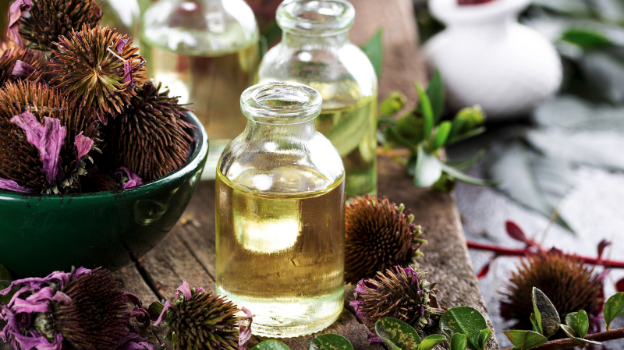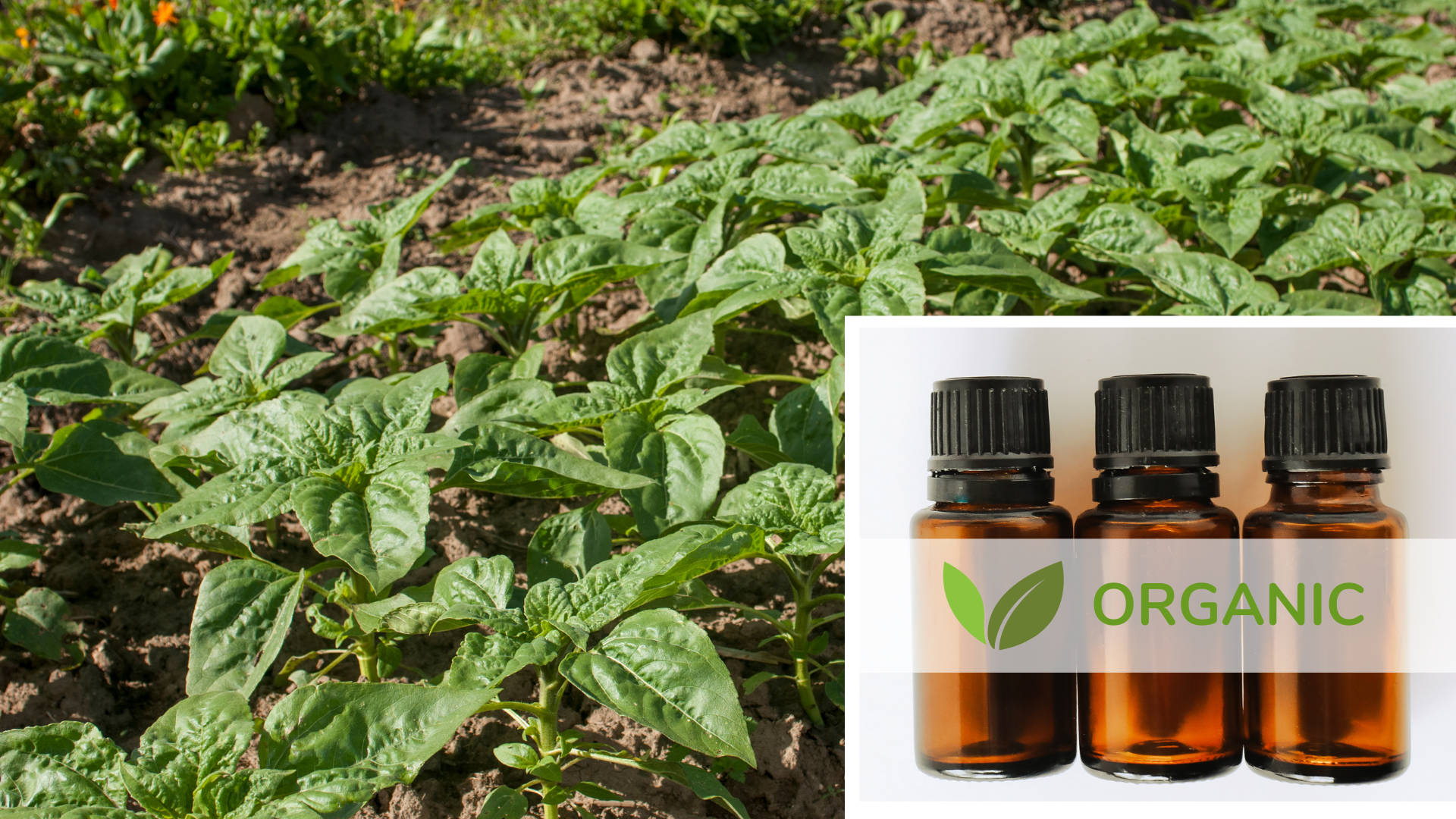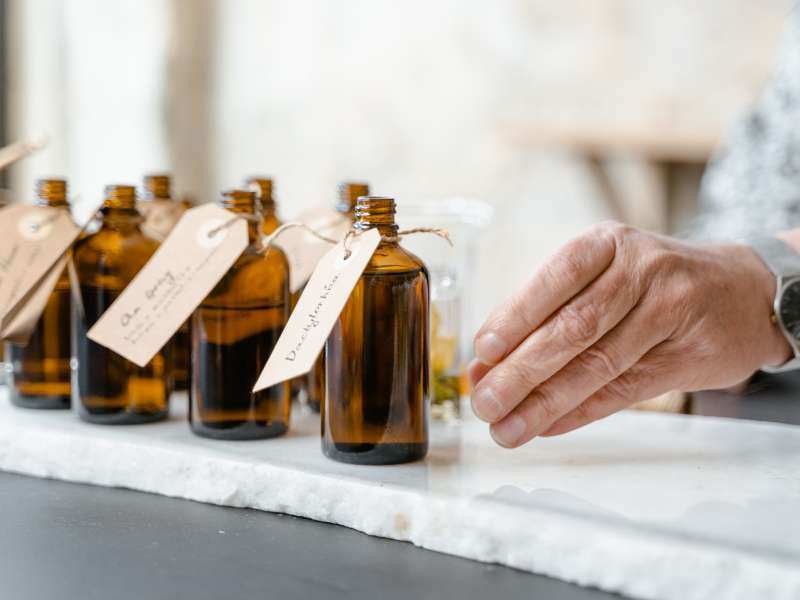Essential oils and herbs are dynamic chemical cocktails. The potency and effectiveness of herbs and essential oils are dependent on these chemical constituents. These complex compounds are responsible for the therapeutic actions that make them prized aromatherapy and herbal medicine components. Understanding the chemistry behind these botanical wonders can illuminate their healing potential and guide us in utilizing their benefits effectively. But how do we ensure an oil or herb contains what it needs to provide the wellness outcome we’re looking for?
A therapeutically active oil or herb means that it is biologically active and does not include diluents, vehicles, specific adjuvants, or ingredients that do not have any therapeutic properties when present alone4. The specific ratio of an oil’s constituents, the active ingredients, provides its specific wellness-enhancing and therapeutic qualities. Read on to learn more about how to determine whether oils and herbs are therapeutically active.
Quality Assurance
Before diving into the specifics of active constituents, it's essential to emphasize the importance of quality assurance. At institutions like the American College of Healthcare Sciences (ACHS), meticulous quality assessment protocols are in place to ensure that herbs and essential oils meet stringent standards. This includes ensuring dried herbs and essential oils are unadulterated and free from contaminants such as pesticides, verifying the correct types and amounts of chemical components, confirming harvest dates, verifying freshness and viability, and ensuring proper storage conditions to prevent degradation1.
Active Constituents in Action
Let's explore a couple of examples to illustrate how active constituents contribute to the therapeutic properties of herbs and essential oils:
- Lavender Lavandula angustifolia: Lavender essential oil is renowned for its calming and soothing effects, making it a staple in aromatherapy for stress relief and relaxation. One of its key active constituents is linalool, a monoterpene alcohol with sedative properties. Linalool acts on the central nervous system, promoting relaxation and helping to alleviate anxiety and insomnia.
- Echinacea Echinacea angustifolia: Echinacea root is a popular herb that supports immune function and fights off colds and flu. One of its primary active constituents is echinacoside, a phenolic compound with potent antioxidant and anti-inflammatory properties. Echinacoside helps to modulate the immune response, enhancing the body's ability to defend against pathogens and reduce inflammation3.
A complete list of primary constituents and the associated essential oils and herbs can be found in the Aromatherapy Essentials: Foundations for Professional Practice book, which is available in paperback and as a downloadable digital copy.
“The chemistry of essential oils can tell us so many things. It can tell us about the therapeutic properties an essential oil might have. It can tell us about safety considerations or toxicity issues concerning an essential oil. It can help us understand the aroma that the essential oil has or the feeling (the viscosity) of an essential oil. Furthermore, it can help us be smarter when we are choosing how to use an essential oil therapeutically or how we might use it in an essential oil blend.” Dorene Petersen, ACHS Founding President
The Power of Quality Botanicals
To experience the full therapeutic benefits of herbs and essential oils, it's crucial to source high-quality botanicals from reputable suppliers. ACHS and the Apothecary Shoppe offer certified organic, pesticide-free products, ensuring that you're getting the purest and most potent botanical extracts.1 2
Whether you're using essential oils for aromatherapy or incorporating herbs into your wellness routine, understanding the role of chemical constituents is key to maximizing their therapeutic potential. By prioritizing quality and embracing the science behind botanical medicine and aromatherapy, we can truly benefit from the healing power of nature and support holistic health and well-being.
At ACHS, the sourcing of quality therapeutic, active excellence begins with a rigorous assessment of the essential oils and herbs. Let's explore the criteria.
How ACHS ensure therapeutic effectiveness in essential oils and herbs
- Quality of the Crop: ACHS prioritizes sourcing essential oils and herbs from reputable suppliers who maintain high standards in sustainable, environmentally aware crop cultivation. The quality of the botanical material directly impacts the potency and effectiveness of the resulting essential oil.3
- Quality of Distillation or Harvesting: The extraction method plays a crucial role in preserving the delicate chemical constituents of essential oils. ACHS ensures that oils and herbs are extracted using methods that maintain the integrity of the plant material and maximize therapeutic benefits.
- Freshness: Essential oils are most potent when they are freshly distilled or harvested. ACHS selects oils that are obtained from recent distillations or harvests to ensure maximum efficacy.
- Certification: ACHS prioritizes essential oils that are certified organic and free from pesticides, herbicides, and other harmful chemicals. Organic certification ensures purity and minimizes the risk of contamination.4
- Pesticide-Free: In addition to organic certification, ACHS verifies that essential oils are pesticide-free. This commitment to purity ensures that oils are free from harmful residues that could compromise their therapeutic value and cause a multitude of illnesses. Read more about organic products here: Are Pesticide-Free Organic Essential Oils Truly Worth the Splurge?
- GCMS Testing: Gas Chromatography-Mass Spectrometry (GCMS) and physical constants testing are powerful analytical tools used by ACHS to verify the authenticity and purity of the oils, quantify their chemical constituents, and confirm their chemotype. ACHS compares the results to international standards and pharmacopeias, ensuring that the oils meet quality standards.
- Color, Aroma, and Feel: ACHS assesses essential oils for their sensory characteristics, including color, aroma, and texture. These sensory attributes can provide valuable insights into the quality and freshness of the oil.
- Third-Party Testing: An independent third-party lab carries out all GCMS, pesticide, and quality testing. ACHS will reject any essential oil with pesticides.
- Latin names: The verification of Latin names ensures accurate plant identification which is vital for herb and oil consistency and safety. Common names vary widely across regions, risking misidentification, but Latin names offer a universal standard, minimizing confusion and ensuring the right plant species are used. This precision prevents harmful mix-ups with similar-looking species, enhancing therapeutic efficacy and dosage consistency in herbal treatments.
- Quality control of herbs: At ACHS, we prioritize the thorough quality control checks of medicinal herbs to ensure the quality and authenticity of each botanical plant material which are crucial for consistent therapeutic outcomes. Following Good Manufacturing Practices (GMP), we conduct rigorous organoleptic and microscopic analyses to confirm identity and detect any signs of adulteration or contamination. Additionally, we meticulously sift through the plant material to eliminate any foreign matter, further enhancing the quality and integrity of our herbal preparations.
“The therapeutic activity of herbs hinges upon their quality and purity. Herbs sourced from reputable suppliers following GMP guidelines ensure consistency and safety in their production. Quality aspects such as organic certification or sustainable sourcing guarantee minimal exposure to contaminants, enhancing the therapeutic potential of the herbs. Additionally, rigorous contaminants testing ensures purity, safeguarding against potential health risks.”Natalya Shepeleva, ACHS’s GMP and Quality Assurance Coordinator
By meticulously evaluating essential oils based on these criteria, ACHS ensures that only the highest quality, therapeutically active oils make it into their product offerings and lab kits that offer hands-on experiential learning. This commitment to quality and excellence reflects ACHS's dedication to supporting clients' and students' health and well-being.
Disclaimer:
This content is for educational purposes only and is not intended to be medical advice. It is not intended to treat, diagnose, cure, or prevent disease. This article has not been reviewed by the FDA. Always consult with your primary care physician or naturopathic doctor before making any significant changes to your health and wellness routine.
Sources:
1) Petersen, D. (2014, January 7). Top 5 Ways to Check Quality of Essential Oils | achs.edu. Health and Wellness Blog. Retrieved February 15, 2024, from https://info.achs.edu/blog/essential-oil-quality
2) Apothecary Shoppe. (2017, November 9). About Us. Apothecary Shoppe. Retrieved April 8, 2024, from https://www.apothecary-shoppe.com/pages/about-us
3) Petersen, D. (2014, January 7). Jan 7, 2014 10:08:00 AM | American College of Healthcare Sciences Top 5 Ways to Check Quality of Essential Oils | achs.edu. Health and Wellness Blog. Retrieved April 8, 2024, from https://info.achs.edu/blog/essential-oil-quality
4) Law Insider. Therapeutically Active Definition. Law Insider. Retrieved April 8, 2024, from https://www.lawinsider.com/dictionary/therapeutically-active






